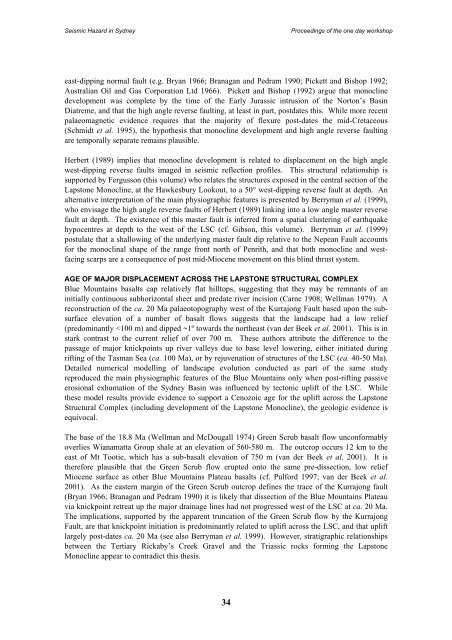Landslides in the Sydney Basin - Geoscience Australia
Landslides in the Sydney Basin - Geoscience Australia
Landslides in the Sydney Basin - Geoscience Australia
- No tags were found...
Create successful ePaper yourself
Turn your PDF publications into a flip-book with our unique Google optimized e-Paper software.
Seismic Hazard <strong>in</strong> <strong>Sydney</strong>Proceed<strong>in</strong>gs of <strong>the</strong> one day workshopeast-dipp<strong>in</strong>g normal fault (e.g. Bryan 1966; Branagan and Pedram 1990; Pickett and Bishop 1992;<strong>Australia</strong>n Oil and Gas Corporation Ltd 1966). Pickett and Bishop (1992) argue that monocl<strong>in</strong>edevelopment was complete by <strong>the</strong> time of <strong>the</strong> Early Jurassic <strong>in</strong>trusion of <strong>the</strong> Norton’s Bas<strong>in</strong>Diatreme, and that <strong>the</strong> high angle reverse fault<strong>in</strong>g, at least <strong>in</strong> part, postdates this. While more recentpalaeomagnetic evidence requires that <strong>the</strong> majority of flexure post-dates <strong>the</strong> mid-Cretaceous(Schmidt et al. 1995), <strong>the</strong> hypo<strong>the</strong>sis that monocl<strong>in</strong>e development and high angle reverse fault<strong>in</strong>gare temporally separate rema<strong>in</strong>s plausible.Herbert (1989) implies that monocl<strong>in</strong>e development is related to displacement on <strong>the</strong> high anglewest-dipp<strong>in</strong>g reverse faults imaged <strong>in</strong> seismic reflection profiles. This structural relationship issupported by Fergusson (this volume) who relates <strong>the</strong> structures exposed <strong>in</strong> <strong>the</strong> central section of <strong>the</strong>Lapstone Monocl<strong>in</strong>e, at <strong>the</strong> Hawkesbury Lookout, to a 50° west-dipp<strong>in</strong>g reverse fault at depth. Analternative <strong>in</strong>terpretation of <strong>the</strong> ma<strong>in</strong> physiographic features is presented by Berryman et al. (1999),who envisage <strong>the</strong> high angle reverse faults of Herbert (1989) l<strong>in</strong>k<strong>in</strong>g <strong>in</strong>to a low angle master reversefault at depth. The existence of this master fault is <strong>in</strong>ferred from a spatial cluster<strong>in</strong>g of earthquakehypocentres at depth to <strong>the</strong> west of <strong>the</strong> LSC (cf. Gibson, this volume). Berryman et al. (1999)postulate that a shallow<strong>in</strong>g of <strong>the</strong> underly<strong>in</strong>g master fault dip relative to <strong>the</strong> Nepean Fault accountsfor <strong>the</strong> monocl<strong>in</strong>al shape of <strong>the</strong> range front north of Penrith, and that both monocl<strong>in</strong>e and westfac<strong>in</strong>gscarps are a consequence of post mid-Miocene movement on this bl<strong>in</strong>d thrust system.AGE OF MAJOR DISPLACEMENT ACROSS THE LAPSTONE STRUCTURAL COMPLEXBlue Mounta<strong>in</strong>s basalts cap relatively flat hilltops, suggest<strong>in</strong>g that <strong>the</strong>y may be remnants of an<strong>in</strong>itially cont<strong>in</strong>uous subhorizontal sheet and predate river <strong>in</strong>cision (Carne 1908; Wellman 1979). Areconstruction of <strong>the</strong> ca. 20 Ma palaeotopography west of <strong>the</strong> Kurrajong Fault based upon <strong>the</strong> subsurfaceelevation of a number of basalt flows suggests that <strong>the</strong> landscape had a low relief(predom<strong>in</strong>antly
















